Low carbon behaviours framework: key behaviour areas - data for Scotland
Report on the uptake of our 10 low carbon key behaviour areas.
Key Behaviour Areas: Food
Food
- Eating a healthy, sustainable diet, high in seasonal food.
- Avoiding food waste
Key Behaviour Areas - Food: Healthy, Sustainable Diet - Summary
There is limited data available to track Scotland's food consumption behaviours over time, both generally, and in relation to sustainable food behaviours. However available data shows that:
- The overall Scottish diet is both less healthy, and has a higher environmental impact, than the recommended 'Eatwell Guide' diet - updated guidance on a healthy diet which is in use across the UK.
- Adult consumption of fruit and vegetables has barely changed in recent years and only one fifth of adults eat the recommended 5 or more portions a day. Many fruit and vegetable will have a low environmental impact compared with other foods, particularly if grown and eaten in season.
Eating a healthy and sustainable diet: Context
Sustainable and Healthy Diet Choices
Food accounts for around 16% of Scottish households' GHG emissions.* Evidence shows that dietary choice can influence the carbon footprint from the food we eat.
The Eatwell Guide was developed by Public Health England to help the UK public eat a healthy, balanced diet.** The Carbon Trust was asked to assess the Guide's environmental impacts compared with the current UK diet. They concluded that it " shows an appreciably lower environmental impact than the current UK diet"***.
The 2 indicators that follow relate to the Eatwell Guide recommendations.
*
Scottish
Government (2016) Low carbon behaviours framework: method to
estimate Scotland's greenhouse gas consumption emissions by
theme
This includes the emissions associated with the production
and transportation of food, but excludes emissions from food waste.
**
Public
Health England: 'The Eatwell Guide' (2016). Its development was
led by Public Health England (
PHE), in
association with the Welsh Government, Food Standards Scotland and
the Food Standards Agency in Northern Ireland.
***
Carbon
Trust: 'The Eatwell Guide: a More Sustainable Diet' (2016)
Eating a healthy and sustainable diet: Key Indicator
Scottish Diet compared with the Eatwell Guide
Food Standards Scotland has used the National Diet and Nutrition Survey for Scotland* to compare the current Scottish diet with the Eatwell Guide**. This data shows that actual Scottish consumption is:
- lower than recommended for fruit and vegetables and bread/rice/pasta;
- higher than recommended for dairy & alternatives, high fat & sugar, and proteins including beans, pulses, fish, eggs and meat.
This indicates that the current Scottish diet is both less healthy, and has a higher environmental impact, than the Eatwell Guide's recommended diet.
Current Scottish Diet (2008/09 - 2011/12) compared with the Eatwell Guide**
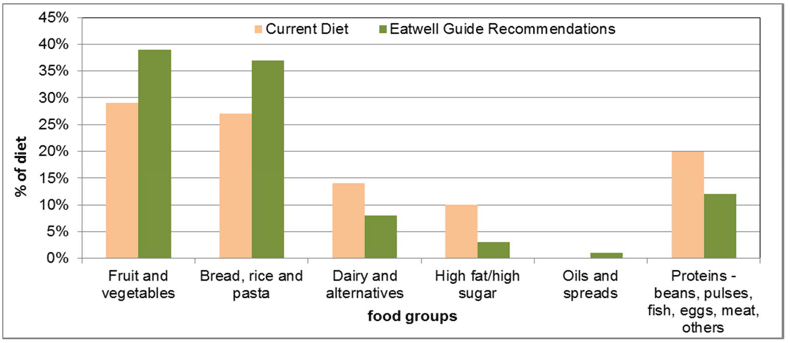
*
Food
Standards Scotland: National Diet and Nutrition Survey for
Scotland
**
Public Health England: 'The Eatwell
Guide' (2016
).
Eating a healthy and sustainable diet
Eating 5 or more portions of fruit and vegetables a day
'Fruit and vegetables' is one of the food groups where Scottish consumption is lower than recommended by the Eatwell Guide. From a health perspective, Scotland's dietary goals include: " Average intake of a variety of fruit and vegetables to reach at least 5 portions per person per day (400+g per day)".*
Adult consumption of fruit and vegetables has barely changed over the past 15 years. Average daily consumption increased from 259g to 263g between 2001 and 2013, equivalent to just over 3 portions a day.** Self-reported data shows that only around a fifth of people ate the recommended 5 or more portions in 2015, with no statistically significant change compared with 2008***.
Adults consuming 5 or more portions of fruit & vegetables a day: 2008 - 2015***
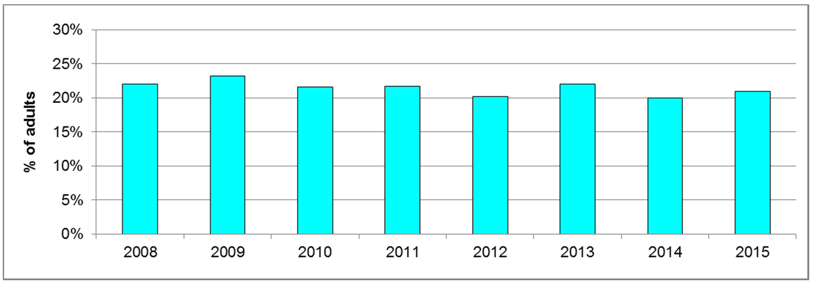
*
Revised Dietary Goals for Scotland, March 2016
**
Estimation
of food and nutrient intakes from Living Costs and Food Survey data
in Scotland 2001-2013
***
Scottish
Health Survey, 2015
Key Behaviour Areas - Food: Food Waste - Summary
There is limited data to show trends in Scottish food waste behaviours over time, partly due to methodological changes in data capture. However available data shows that:
- Disposal of food waste: there has been a steady increase in the number of people using food waste recycling caddies, rather than throwing food waste out with general waste.
- Disposing of uneaten food: just over half of people say they throw away little or no uneaten food. Only 1% say they throw away a lot of uneaten food.
- Reusing leftover food: more people say that they reuse leftover food rather than throwing it away. Almost half use leftovers as part of another meal. However 1 in 6 say they throw leftover food away.
Emissions from food waste
An estimated 60% of Scottish household food and drink waste is avoidable.*
Emissions associated with this avoidable waste are estimated to be equivalent to 1.5 million tonnes of CO2 each year. Avoiding these emissions would be equivalent to removing 1 in every 4 cars from Scottish roads.*
In 2016 the Scottish Government set a target to " reduce all food waste arising in Scotland by 33 per cent by 2025". This was described as important in " reducing the environmental impact of food consumption and production (to help) in tackling climate change".**
*
Zero
Waste Scotland / WRAP Scotland 'The Food We Waste' (updated
2012)
**
Scottish Government:
'Making Things Last - A Circular Economy Strategy for Scotland'
(2016)
Avoiding food waste
Disposal of Food Waste
Food Waste Disposal Methods in the last week:
2012-2015*
(
NB: multiple responses were
possible)
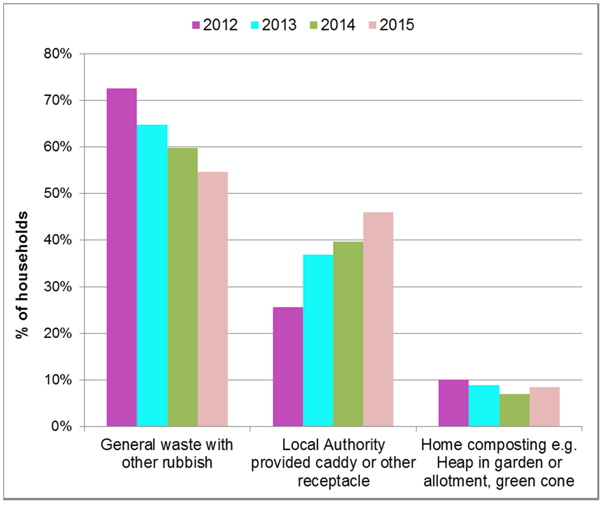
Since 2012 the Scottish Household Survey has included a question about methods used to dispose of food waste in the last week. This could include avoidable or unavoidable waste.
The proportion of people who use a food caddy or equivalent has increased from 26% in 2012 to 46% in 2015. There has been a similar decrease in the proportion of people disposing via general waste. These trends are likely to reflect the increasing availability of household food caddies and kerbside food recycling.
* Scotland's People: Results from 2015 Scottish Household Survey
Disposal of Uneaten Food
Uneaten food thrown away by quantity (self-reported): 2011-2016*
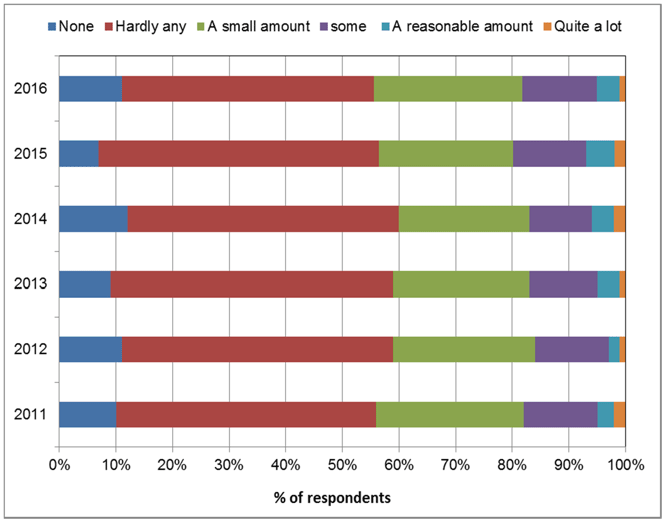
NB: there have been methodological changes in data capture over time, so direct comparisons between years are not valid in every case.
55% of people say they throw away little or no uneaten food, and only 1% say they throw away quite a lot*.
However, 2010 data suggested that food and kitchen waste accounted for almost a third (31.5%) of all household waste - by far the biggest share by waste type**. This suggests that people are not always aware of how much food they are throwing out.
* Zero Waste Scotland/ WRAP Consumer Food Waste Prevention
Tracker Surveys (annual spring data)
**
Zero
Waste Scotland (2010) The Composition of Municipal Solid Waste in
Scotland
Reusing Leftover Food
More people say they reuse leftover food than say they throw it away.
Almost half of Scots use leftovers as part of another meal, and more than a third use leftovers as a meal in themselves.
Around 1 in 6 people say they throw leftovers away**.
Household usage of leftover food (self-reported):
2011-2016*
(
NB: multiple responses were
possible)
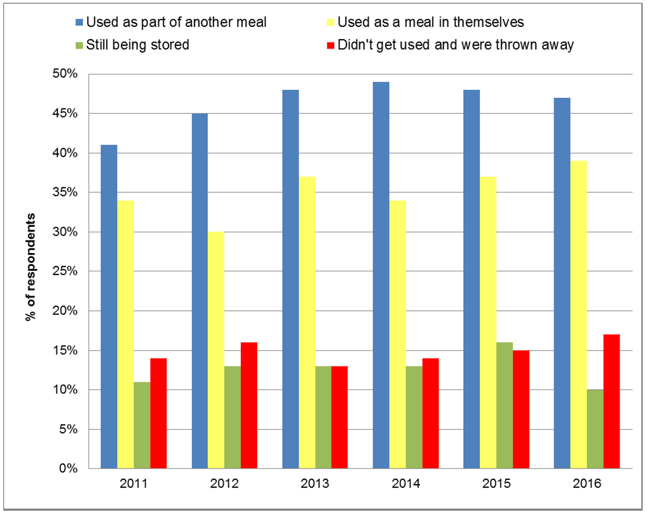
* Zero Waste Scotland/ WRAP Consumer Food Waste Prevention Tracker Surveys (annual spring data)
Contact
There is a problem
Thanks for your feedback